The short poem “Eight Verses for Training the Mind” is a famous example of a special Tibetan genre called mind training (lojong). The word mind here refers to both the conventional and ultimate minds of enlightenment—the altruistic intention to become enlightened as well as the direct realization of emptiness by someone endowed with this altruistic intention.
Mind training in its broadest sense means developing altruism and realization of the nature of all phenomena, topics relevant for any practitioner. Only the final two lines of the eighth verse explicitly address cultivation of the ultimate mind of enlightenment, but the two practices interact synergistically to enhance each other and help make each other possible; thus, as daily reflection and meditation, the two work hand in hand.
The practice of focusing on the welfare of others undermines the usual emphasis on oneself, thereby opening the possibility for progress toward diminishing the self’s inflated status, the primary impediment blocking the realization of the emptiness of all phenomena. And the advice on compassion found in the first seven and a half challenging verses is so contrary to ordinary attitudes that working at realizing emptiness, which involves seeing phenomena as like illusions—appearing one way while actually existing another way—opens the way for this radical turn toward emphasizing others.
The composition of pithy, practical, provocative texts like this one began as a genre in 11th-century Tibet with the founding of the Kadam school by Dromtonpa, the principal student of the Indian master Atisha (982–1054). The Kadam tradition is embraced by all Tibetan schools as a common heritage.
The author of this text, Geshe Langri Thangpa, was born Dorje Sengge in Central Tibet in the year 1054. He eventually became a student of Potowa, himself a primary disciple of Dromtonpa. The author and his poem “Eight Verses for Training the Mind” enjoy such popularity that both continue to be cited over and over within the mind training tradition and throughout the Tibetan cultural region, which includes the Kalmyk Mongolian areas near the Volga River, the Mongolian People’s Republic, Inner Mongolia, the Republic of Buryatia, Bhutan, Sikkim, Ladakh, and parts of Nepal.
Geshe Langri Thangpa is famed for his realistic assessment of the vagaries of life impelled by lust and anger, which are themselves driven by rampant ignorance. He was known as “Gloomy Face”—it is said that he seldom smiled—but it is obvious from the central message of the poem that he took delight in others, seeing them as magnificent, magical jewels that yielded unimaginably wonderful results through caring, compassionate expression. Thus, part of the task in reading and absorbing the extraordinarily challenging advice of these lines is to imagine the mind and heart of the author—the ground, the perspective from which he speaks—as these injunctions clatter against our ingrained selfishness, hurt, and rage. A sense of humor might also help us along the way.
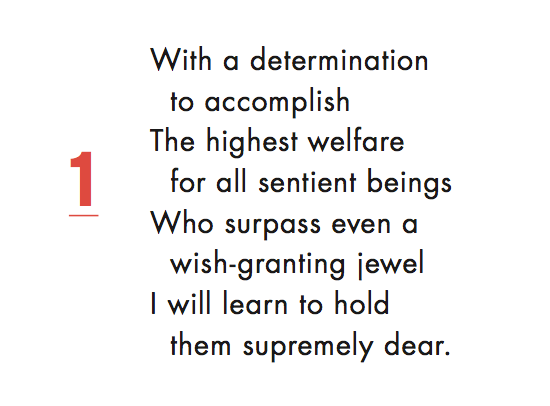 Other sentient beings are the basis, the support, in dependence upon which we can accomplish many of the goals that we want, including better rebirths, eventual freedom from cyclic existence, and even the highest enlightenment of buddhahood, a state of freedom from counterproductive emotions and the confines of a limited mind. How could this be? One of my 21 teachers, Kensur Lekden, emphasized that the power of a virtue is magnified by as many beings to whom you dedicate the merit. Thus, if after doing a worthwhile deed you imagine its worth to be imbued into others, the value of that deed is multiplied by their number.
Other sentient beings are the basis, the support, in dependence upon which we can accomplish many of the goals that we want, including better rebirths, eventual freedom from cyclic existence, and even the highest enlightenment of buddhahood, a state of freedom from counterproductive emotions and the confines of a limited mind. How could this be? One of my 21 teachers, Kensur Lekden, emphasized that the power of a virtue is magnified by as many beings to whom you dedicate the merit. Thus, if after doing a worthwhile deed you imagine its worth to be imbued into others, the value of that deed is multiplied by their number.
It is best to begin with specific persons and slowly expand to more, so as not to turn the dedication into a vague or even rote mouthing of words. This way, other sentient beings actually do become wish-granting jewels, bestowing greater favors than money or material goods could ever confer.
This is very difficult to practice. When we are faced with what interferes with our desires, or what we deem as “good,” we want to strike out somehow. Rage is ready to pounce! How could an asinine politician blocking a sensible program to help the destitute be a wish-granting jewel?
But this is just the point. Encountering a person we view as vile, we are given the chance to see our rebellion against a truly altruistic attitude as well as the enormity of the task of holding all beings dear. The vile provide opportunities to build character and to practice patience, and hard times are a great opportunity for advancement along the path.
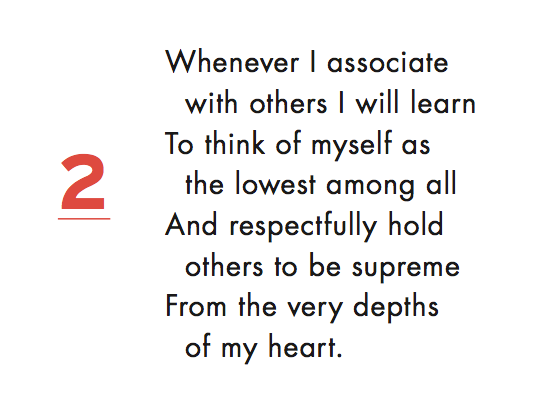 Pride gets in the way of seeing others’ good qualities and prevents the development of one’s own. The great Indian scholar-yogi-poet Nagarjuna, in his work Precious Garland, speaks of seven types of pride, which are so all-encompassing that they might make you want to crawl under a rock:
Pride gets in the way of seeing others’ good qualities and prevents the development of one’s own. The great Indian scholar-yogi-poet Nagarjuna, in his work Precious Garland, speaks of seven types of pride, which are so all-encompassing that they might make you want to crawl under a rock:
- Pride of selfhood: fancying that one is lower than the lowly, or equal with the equal, or greater than or equal to the lowly;
- Excessive pride: boasting that one is equal to those who by some good quality are superior to oneself;
- Pride beyond pride: fancying that one is superior to the superior, thinking that one is higher than the very high;
- Pride of thinking “I”: through obscuration, conceiving an “I” in the five empty aggregates of mind and body;
- Pride of conceit: thinking one has won fruits of the spiritual path not yet attained;
- Erroneous pride: praising oneself for faulty deeds;
- Pride of inferiority: deriding oneself, thinking “I am useless.”
If others are wish-granting jewels, it makes sense to consider myself the lowest of all in calculating my relations with them, but according to the above list Nagarjuna takes this comparison to be a form of pride as well! Indeed, those who trumpet or even insinuate their status relative to those worse off than or equal to them reek of pride, but would this not apply to thinking myself as the lowest among all, as the stanza instructs? The key lies in the qualification that this view is felt from the very depths of my heart, where assuming our own lowliness is a direct expression of the appreciation of others being wish-granting jewels.
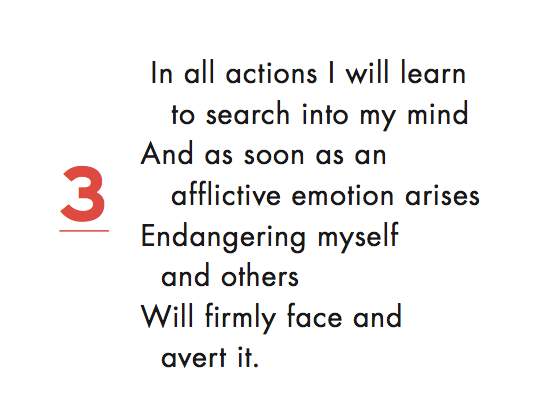 Afflictive emotions are so named because they make a mess of any situation. They are destructive, counterproductive, problematic, self-defeating, troublesome, twisted, warped, harmful, exaggerated, distressing, unfavorable, negative, painful, poisonous, and hurtful. The three root afflictive emotions are lust, anger, and ignorance, with ignorance being the source of the other two. Ignorance exaggerates the status of oneself, others, and objects, and on this basis lust and anger obtain a foothold, spawning a host of problems listed as the 20 secondary afflictive emotions: belligerence, resentment, concealment, spite, jealousy, miserliness, deceit, dissimulation, haughtiness, harmfulness, lack of self-concern, lack of concern about others, lethargy, wild desire, lack of faith, laziness, non-awareness, forgetfulness, lack of introspection, and distraction. A mess, indeed, that endanger[s] myself and others.
Afflictive emotions are so named because they make a mess of any situation. They are destructive, counterproductive, problematic, self-defeating, troublesome, twisted, warped, harmful, exaggerated, distressing, unfavorable, negative, painful, poisonous, and hurtful. The three root afflictive emotions are lust, anger, and ignorance, with ignorance being the source of the other two. Ignorance exaggerates the status of oneself, others, and objects, and on this basis lust and anger obtain a foothold, spawning a host of problems listed as the 20 secondary afflictive emotions: belligerence, resentment, concealment, spite, jealousy, miserliness, deceit, dissimulation, haughtiness, harmfulness, lack of self-concern, lack of concern about others, lethargy, wild desire, lack of faith, laziness, non-awareness, forgetfulness, lack of introspection, and distraction. A mess, indeed, that endanger[s] myself and others.
To face and avert the afflictive emotions, it may be sufficient for the moment to pay attention to something else or to reflect on the disadvantages of a hasty engagement. There are also specific techniques to counter certain afflictive emotions: lust for someone’s body, for instance, can be staved off by imagining what is under the person’s skin (or even imagining that it erupts outside the skin!), and hatred can be foiled by cultivating love or at least trying to bring the person’s good qualities to mind. Supreme of all, it is said, is to reflect on the emptiness of inherent existence, for it is a phenomenon’s seeming concreteness that forms the basis for lust and hatred (more on this later). Here in this stanza, however, the suggestion is that the pull to lust and hatred results from insufficient concern about the danger to oneself and others, meaning insufficient knowledge about the karmic results for oneself and insufficient love and compassion for others.
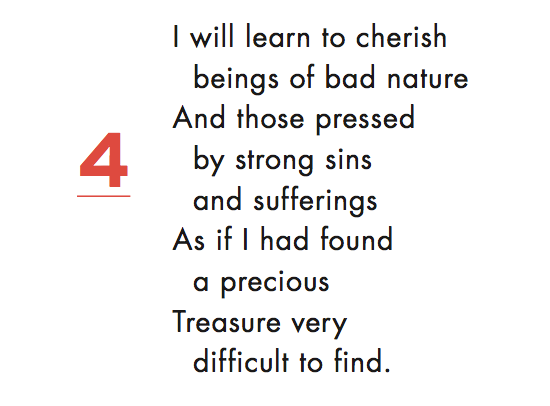 Our moods are so reliant on exaggeration that even a slight interference can upset them. As a friend once said, “the sight of homeless people really wrecks my good mood.” Damn them! He was being honest, trying not to avert his gaze from their suffering or from his own reaction. But what does it mean that his good mood is so vulnerable? Many of our mind-states are built on exaggerating favorable qualities while ignoring unfavorable ones. Without those exaggerations, the homeless—or illness or sudden tragedy—would fit right in.
Our moods are so reliant on exaggeration that even a slight interference can upset them. As a friend once said, “the sight of homeless people really wrecks my good mood.” Damn them! He was being honest, trying not to avert his gaze from their suffering or from his own reaction. But what does it mean that his good mood is so vulnerable? Many of our mind-states are built on exaggerating favorable qualities while ignoring unfavorable ones. Without those exaggerations, the homeless—or illness or sudden tragedy—would fit right in.
Even those politicians who deliberately reject programs for the poor should be recipients of our compassion, as should those who deliberately attack us either in word or deed. And yet these people are usually the ones who arouse our worked-up hatred. Such persons are precious treasures very difficult to find because it is in relation to them that we can truly practice.
What if a close friend’s mind becomes corrupted and he transforms into one of these persons with evil intent? We would feel deeply upset about their attitude shift and would want to see them change. Compassion is not quiet; it is an enthusiastic, active, empathetic wish to help. Some claim we need anger to add power to compassion, but anger is the result of exaggerating negative qualities to the point of blinding effective action. Compassion is by no means weak; it is itself powerful.
I cannot claim the ability to cherish beings of bad nature. (If I did, it would be the fifth pride.) But we can all aspire to be able to do so in the midst of onslaught. When delayed at a clogged airport, for instance, I remember this teaching and repeat, “This is a chance to build character. This is a chance to build character,” and it helps.
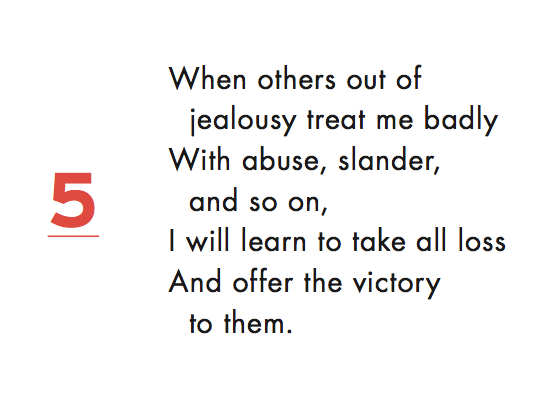 This one is especially difficult. If I give in to an attacker, I think, he or she will grab the victory banner and wave it even harder. And onlookers will think the person must be right because I am not responding.
This one is especially difficult. If I give in to an attacker, I think, he or she will grab the victory banner and wave it even harder. And onlookers will think the person must be right because I am not responding.
Taking all loss is not a subtle technique for gaining the upper hand, as remaining silent sometimes is. It is an instrument for putting the view that others are precious treasures very difficult to find into action. Being treated badly is a special opportunity to practice patience and forbearance. Through putting up with difficulty, great internal progress is achieved. (And every once in a while external progress is achieved, too: sometimes the other person, in the absence of my expected upset, becomes befuddled, even amazed.)
In certain circumstances, a substantial loss that is harmful to you as well as others should not be sustained, and thus a forceful response must be initiated—but only while remembering that your attacker, like you, wants happiness and does not want suffering. Still, it can be unbearably difficult not to become brutal in both thought and deed, with repressed rage suddenly controlling speech and then body, revealing that the attempt to take all loss and offer the victory to them was self-delusion, a mere saccharine display of manikin compassion. But better to give over to anger than to claim religious paternalism: “I am screaming at you because I love you!” Fake on top of fake! Watching my own hideously fake attempts, I have even broken out laughing; a sense of humor is crucial for trying to implement such a difficult practice without further covering up dark impulses.
Remember that we have been caught in beginningless cyclic existence by extremely deep-seated errors. As one of my Tibetan teachers who had practiced sudden enlightenment for quite some time exclaimed, “How long can you practice sudden enlightenment?” We often take the possibility of sudden enlightenment as an excuse for thinking that attitudes easily change. But they usually don’t, even though we can take remarkable turns and have life-altering experiences. These marvelous spiritual events have to be kept in their place; we must refrain from using them to hide from recognizing the afflictive emotions that continue to arise. We shouldn’t fantasize subsequent afflictive emotions and destructive actions into being part of a spiritual biography.
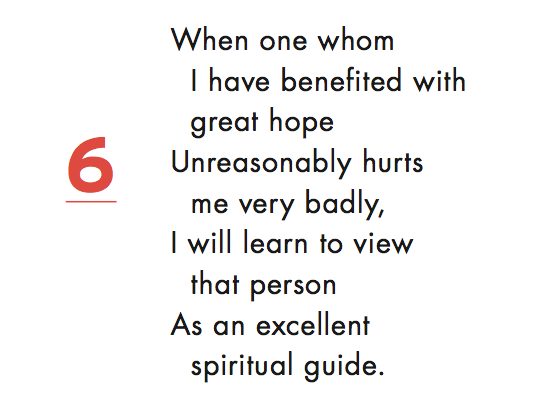 Paying attention to the topsy-turvy nature of cyclic existence—friend becomes enemy, enemy becomes friend, friend or enemy forgets you or you forget them—prepares us for being turned against by even those whom we have gone out of our way to help. Don’t think that you are safe from this kind of person; far from returning your kindness, they may, for whatever known or unknown reason, seek to undermine your every move and, on top of that, delight in your failure and suffering.
Paying attention to the topsy-turvy nature of cyclic existence—friend becomes enemy, enemy becomes friend, friend or enemy forgets you or you forget them—prepares us for being turned against by even those whom we have gone out of our way to help. Don’t think that you are safe from this kind of person; far from returning your kindness, they may, for whatever known or unknown reason, seek to undermine your every move and, on top of that, delight in your failure and suffering.
Here we are being advised to recognize that even this person is (wow!) a wish-granting jewel. An excellent spiritual guide. An unparalleled chance to practice patience.
The Dalai Lama often says, to my utter disbelief, that you cannot have a chance to practice patience with your guru. Give me a break! He must say this because a guru has a basic intention to help, but this would be like trying to tell myself I had no opportunities to practice patience with my mother when she was screaming unfounded insults at me just because she claimed, in calmer moments, that she did so out of love, or because the convention is that mothers always (every moment?) love their children.
But the opportunity for seeing that this person wants happiness and does not want suffering, just as I do, is still there. And the opportunity for wishing the person to be truly free from suffering and imbued with true happiness is still there, too. To be stuck on the person’s motivation is a waste.
There is no need to mention that this practice is extremely difficult. It is said that it is easy to explain the practices of compassion but hard to enact. But imagine the changes in our emotional life if we could actually internalize the perspective of this verse!
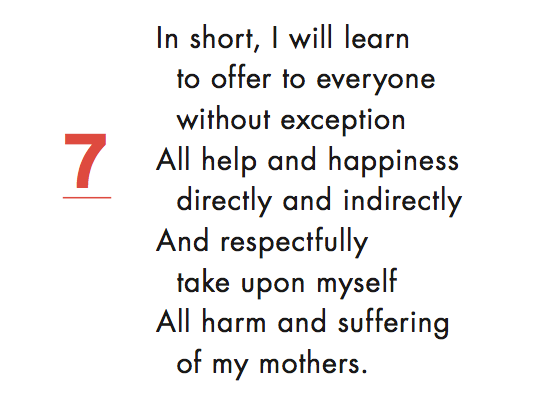 The practice of giving all of one’s pleasant karmic effects to others and drawing all unpleasant karmic effects into oneself suggests that in ordinary life we are unconsciously, and sometimes consciously, doing the opposite (and at the least we are relieved when pestilence is somewhere else and not bothering us). I have practiced visualizing sucking in others’ sickness in the hospital, usually when entering the building, but I often forget to do the technique in daily life, except when pressed with severe physical distress like stomach ailments. At these times, the practice suddenly appears: “May my pain substitute for the pain of stomach upset of all sentient beings!” I think it over and over, and calm sets in. As a girl who was in the next hotel room in Dharamsala, India, once said to me after hearing upchucking all night, “I was sure you were going to die,” though I was actually smiling from the rarefied meditative state I was in. A mild version of this practice is to take joy in someone else’s getting to a parking spot before you do. Why make yourself upset?
The practice of giving all of one’s pleasant karmic effects to others and drawing all unpleasant karmic effects into oneself suggests that in ordinary life we are unconsciously, and sometimes consciously, doing the opposite (and at the least we are relieved when pestilence is somewhere else and not bothering us). I have practiced visualizing sucking in others’ sickness in the hospital, usually when entering the building, but I often forget to do the technique in daily life, except when pressed with severe physical distress like stomach ailments. At these times, the practice suddenly appears: “May my pain substitute for the pain of stomach upset of all sentient beings!” I think it over and over, and calm sets in. As a girl who was in the next hotel room in Dharamsala, India, once said to me after hearing upchucking all night, “I was sure you were going to die,” though I was actually smiling from the rarefied meditative state I was in. A mild version of this practice is to take joy in someone else’s getting to a parking spot before you do. Why make yourself upset?
Just as mothers are nurturers, so are all sentient beings. As wish-granting jewels, when all goodness is given to sentient beings, including one’s own positive karma, it is multiplied. Remember that everyone, at some time over the beginningless course of lives, actually was your nurturer, caring for you as much as your kindest friend.
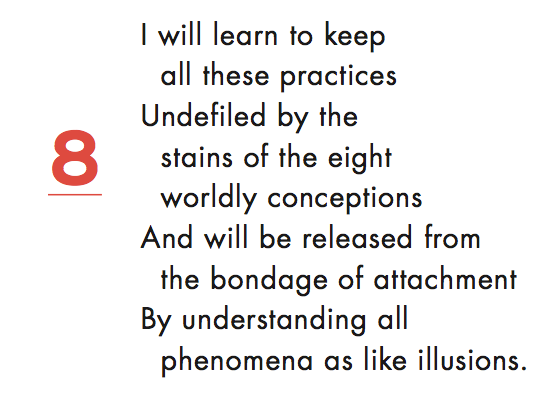 What stands in the way of these practices are the eight worldly fascinations—like and dislike; gain and loss; praise and blame; and fame and disgrace. Oh, to be free of their embrace!
What stands in the way of these practices are the eight worldly fascinations—like and dislike; gain and loss; praise and blame; and fame and disgrace. Oh, to be free of their embrace!
Such concerns don’t simply stain these practices; they prevent them from getting started. Hold the door for me, and I feel like royalty; give me a little piece of chocolate, and I smile from the core; frown at me, and I shrivel.
The other side of mind training is cultivation of the wisdom that realizes the emptiness of inherent existence. It does so by analyzing “me”—who wants this and is afraid of that—and subjecting it to analytical rigor until, though it might appear to exist so hard, so forthright from its own side, you experience that it simply does not. The aim is to live within a view born from analysis knowing the conflict between appearance and reality such that even the appearance of inherent existence promotes knowledge of its emptiness. This is what is meant by understanding all phenomena as like illusions.
An old Indian story goes that a magician could use a mantra to affect how everyone present, both audience and magician, mistakenly sees a mere stone or twig as a beautiful person, a luscious meal, a horse, or an elephant. The audience is drawn into all sorts of conceptions about what they see, leading to desire and so forth, but the magician is not because he knows that these illusions are only appearing because of the mantra.
Phenomena are like this: they appear to exist within themselves in their own right, but they do not exist this way. In order to see ourselves and other phenomena as like illusions, it is necessary to understand that they are all empty of the concrete status they seem to have. We must see that we have an ingrained ignorance that simply and innately assents to these appearances, much like how we accept the appearances of a dream as reality in our sleep. We have to learn that this fundamental misunderstanding draws us into endless troublesome emotions.
Understanding all phenomena as like illusions releases us from the bondage of attachment, which here stands for the entire scope of afflictive emotions. These last two pithy lines in the eighth stanza thereby call for implementing the type of analytical searches for these seemingly solid phenomena that Nagarjuna presents in such intimate detail in his Treatise on the Middle Way and for other types of intense search, such as watching from where conceptions arise, where they abide, and into what they go.
Working at realizing emptiness also broadens the practice of compassion by undermining the very process of being drawn into emotions that endanger self and other. Similarly, cherishing others as wish-granting jewels and recognizing that others want happiness and do not want suffering, just as one does oneself, open the way toward realizing the emptiness of inherent existence by breaking down the barrier of overemphasis on oneself. These are the two fused aspects of mind training.